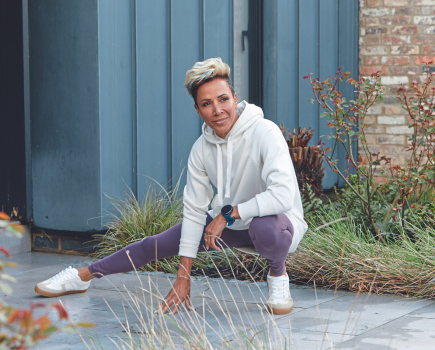Did you know that heart health during exercise isn’t just a matter of raising your heart rate? While cardio exercise is an obvious choice when it comes to protecting your heart, broadening your workout style will offer even more benefits!
Most cardiac experts agree that when it comes to exercise, cardio (or aerobic) activities are the best sort for your heart. After all, the clue is in the name! But research also suggests that finding a weekly balance between the three main types of exercise – cardio, resistance and flexibility – could bring optimum heart health.
‘These activities all complement each other,’ says Chris Allen, senior cardiac nurse with the British Heart Foundation (bhf.org.uk). ‘So to really reap the health benefits, most people should try to incorporate all three types of exercises into their regime.’
It is a good idea to try to fit in strength exercises on two or more days a week according to the NHS, on top of either 150 minutes of moderate aerobic activity, such as brisk walking, or at least 75 minutes of vigorous aerobic activity, such as running. And remember that many activities will cross the boundaries between different types – cycling, for example, can be both a cardio-boosting and a strength-building activity.
Whether you’re hiking, squatting or stretching, it’s important to remember that exercise alone cannot guarantee your heart will flourish. Living with a healthy BMI, being wary of salt, knowing your cholesterol levels and drinking in moderation are all also very important. ‘Many people wrongly believe that they can eat whatever they like, because exercise will counteract it,’ says Chris. ‘But you can’t out-run a bad diet! Try to have a holistic view of your health, and make sure both your diet and your exercise regime are nourishing your body.’
Get your heart pumping with cardio
Cardio activities such as running, brisk walking, rowing, swimming or cycling are all fabulous for your heart. ‘Cardiovascular exercise makes the heart stronger and more efficient at pumping blood around the body,’ says personal trainer Stephen Macconville (nuffieldhealth.com).
‘Regular cardio will lower your resting heart rate, and your blood pressure. Having lower blood pressure puts less stress on the circulatory system, meaning you’re less likely to develop cardiovascular disease.’ Cardiovascular exercise is brilliant, not only for the heart itself, but for the systems in which the organ functions. For example it is known to reduce levels of ‘bad cholesterol’ LDL, so helping you to maintain clean arteries.
Build your muscles

Resistance or strength workouts commonly involve weight training, but can include any type of exercise where you lift or pull against some form of resistance. So you might, for example, use the resistance of your own bodyweight to do moves such as press-ups or squats.
‘Strength exercises will help to keep your blood pressure and blood sugar under control,’ says Chris. ‘They’re also really useful for managing your weight, and building and maintaining good bone health.’
In fact, static exercises (such as weight lifting) could even improve certain key markers of heart health more than dynamic activities (such as cycling) according to a recent study at the University of Grenada. ‘Having strong muscles through resistance training will boost your metabolism, helping you burn fat more easily and putting less stress on your heart,’ says Stephen.
- Look the part in Alice Liveing’s bargain gym wear from Primark!
Flexibility exercises
Activities that develop flexibility – think tai chi, yoga and stretching – don’t always have much direct impact on your heart, although fast-paced yoga flow classes can get your blood pumping.
Nevertheless, by guarding against injury and by keeping you supple, flexibility work can help you stay exercising regularly for longer. As such, flexibility is something of an unsung hero when it comes to heart health – plus, by supporting our mental health, it can have further, indirect benefits.
‘Many people who are stressed cope by smoking, drinking alcohol and eating processed foods,’ says Chris. ‘You can protect your cardiac fitness by turning to something like yoga instead as there’s a lot of evidence that yoga can help to relieve stress.’
Risk factors for cardiovascular disease have been shown to improve more in those doing yoga than in those doing no exercise, according to a study published in the European Journal of Preventative Cardiology.
Want to put all the pieces together? Follow the Top Santé Heart Health Plan and you’ll be getting a good mix of exercise to protect your ticker.

Heart health workout plan
Follow our weekly fitness plan for optimum cardio, strength and flexibility benefits!
MONDAY
BODYWEIGHT RESISTANCE
Kick the week off with a bodyweight resistance workout. Start with squats, press-ups, forward lunges, sideways lunges and double leg raises (lying on your back). This routine should work all the major muscles in your legs, hips, back, abdomen, chest, shoulders and arms.
Do each exercise 10 or 15 times, and repeat each set three times. To get the most heart health benefits, you need to finish each set feeling that you would struggle to complete another repetition. You should be a little sweaty and out of breath!
It’s up to you how long you rest between each set, but you can take up to a minute.
TUESDAY
FLEXIBILITY
Time to combine some strength and flexibility work at a relaxing but super conditioning Pilates or yoga class.
Why not try power walking to your class, to rack up some more moderate activity minutes for the week?
WEDNESDAY
CARDIO
‘Hump day’ is a great time to pack in some cardiovascular exercise – and there’s nothing easier or more inspiring than lacing up your trainers for a run.
If you can bring a friend along, that’s even better, but make sure you’re running at a pace where you can’t say more than a few words without pausing for breath.
Try to incorporate some hill and interval training, for example, by challenging yourself to sprint between lamp posts and trees.
If you struggle to run for a full half hour then don’t worry, you can power walk whenever you need to.

THURSDAY
REST
It’s a rest day – and you’ve earned it. Your heart, mind and joints will thank you for staying mobile though, so try to add some walking and stretching into your day.
FRIDAY
STRENGTH TRAINING
Hit the gym (or your living room) for a strength workout, using medium dumbbells. Stephen suggests a round of press-ups, bent over rows, chest presses and squats (with dumbbells on your shoulders, if you can). Do three sets of 10-15 repetitions each, with no more than 60 seconds of rest in between.
If you are at all unsure how to do any of these moves, check with a personal trainer, or join a strength class at your local gym. You could also repeat Monday’s workout, which will give you a heart-conditioning resistance boost.
SATURDAY
CARDIO
It’s the weekend, so let’s celebrate with some joyful cardio! The key thing here is to make sure you go for something that you truly enjoy.
Swimming is an incredible whole-body workout, which torches calories and develops your cardio-respiratory fitness without putting pressure on your joints. Because you have to cut through the resistance of the water, it will also tone and strengthen your body at the same time.
It’s tempting to stick to a leisurely breaststroke, but make sure you do backstroke and front crawl too – front crawl will give you the most vigorous cardio workout. See if you can introduce a few swim sprints, perhaps once every 10 lengths.
SUNDAY
FLEXIBILITY
While Sunday is traditionally a rest day, incorporating some yoga or Pilates, with a focus on relaxation, is
a great way to end your week.







